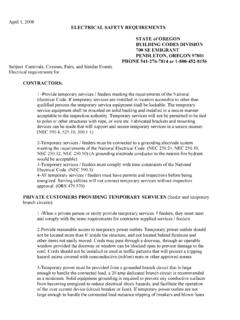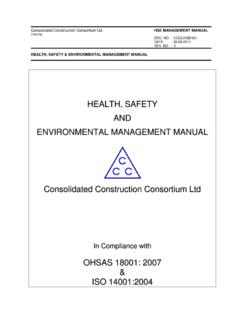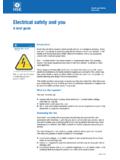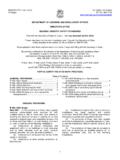Transcription of grounding rods marking & compliance …
1 88 IAEI NEWS 2008 rods marking & compliance requirementsby Jim LundIn today s electrical environment, a wide array of in-stalled ground rod electrodes does not meet the re-quirements of the National electrical Code. Ground rods less than in diameter, rods that were cut in half either because of driving difficulty or to reduce expenses, or rods with less than the required coating thickness ( , copper, zinc) are all examples of ground rods that are presently being installed in violation of the NEC and/or local electrical codes.
2 Ground rods that are cut in halfNEC (A)(5) states: rods and pipe electrodes shall not be less than m (8 ft.) in length. Once a rod is in the ground how does the electrical inspector know that the electrode is 8 feet in length? The best way for the inspector to have the highest degree of confidence that the rod was manufactured in compli-ance with the minimum length (8 feet) is to assure that the permanent certification marking is easily visible on the rod electrode. Listing agencies including CSA, ETL, UL, etc., only certify rods that are 8 feet or an individual were to cut a legitimate rod in half and attempt to use both portions as complete electrodes, the listing mark would be on only one of the two rod sections.
3 Also, should a rod be driven only to a portion of the depth due to rock or other restraints and the top portion were to be cut off, the driven section would not contain the certification marking . The location of the marking adds to the credibility of the inspection process for the authority having jurisdiction (AHJ). Therefore, one may conclude that by verifying the listing mark, one has the highest degree of certainty that the ground rod electrode fulfills all requirements of the NEC, spe-cifically the required 8-foot rods less than in diameterWith regard to diameter requirements , NEC (A)(5)(b) states, grounding electrodes of stainless steel and copper or zinc coated steel shall be at least mm (5/8 in.)
4 In diameter, unless listed and not less than mm (1/2 in.) in diameter. Unless an electrical inspector has a micrometer or sim-ilar device, how can he be sure that the rod is 5/8-inch ( ) in diameter? Visually confirming the listing marks presence indicates the highest degree of certainty that the rod fully complies with the diameter requirements of the NEC. Listing agencies CSA, ETL, MET, UL, etc., will only list rods that are greater than inch in diameter and that have the correct minimum amount of copper or zinc (galvanized) mil thickness many years galvanized rods were sold that were smaller than inches in diameter; nor were they listed.
5 The non-compliant rods measured approximately inches in diameter, too small of a variance for the naked eye of the inspectors to detect. They did not meet Code. It wasn t until the inspectors started rejecting Ground RodsMarking &ComplianceRequirementsGround RodsMarking &ComplianceRequirements 2008 IAEI NEWS 89grounding rods marking & compliance requirementsthese non-compliant diameter rods that the market was forced to offer either a full 5/8 inch ( ) diameter rod or a ground rod that is listed by a certification agency. Ground rods with less thanthe required coating thicknessToday there are inch copper ground rods sold in select markets that do not meet the NEC either for length, for coating mil thickness, or for minimum diameter re-quirements.
6 They are not listed, and do not conform to the listing agencies requirement of a minimum of 10 mils of copper. They are smaller than the required inch ( ) in diameter. Again, the difference is too small to be detected by the naked eye of the electrical inspector. These are examples of why it is important for an inspector (AHJ) to look for the listing mark on all electrical prod-ucts during these times of rampant violations of product compliance . The best way to do this is to require listed products which provide the highest product quality, safe-ty of equipment for long term use, and personnel safety during the installation and maintenance few inspectors who possess a micrometer may be able to accurately measure the diameter of a driven ground rod, but once the electrode is driven into the earth they are unable to verify the length for NEC-com-pliance.
7 To comply with listing certification specifica-tions ground rods must be permanently marked within the top 12 inches of the drive or chamfer end. Not only is the marking within the top 12-inches, but that is the only acceptable location of the marking per product stan-dard UL 467, the governing specification in this of the listing agenciesThere has been some confusion regarding the involvement of the listing agencies. NEC- 2008 Article 100, Defini-tions, states, Listed. Equipment, materials, or services included in a list published by an organization that is acceptable to the authority having jurisdiction and con-cerned with evaluation of products or services, that main-tains periodic inspection of production of listed equip-ment or materials or periodic evaluation of services, and whose listing states that either the equipment, material, or service meets appropriate designated standards or has been tested and found suitable for a specific purpose.
8 There are several agencies that list equipment, materi-als and/or services including CSA, ETL/Intertek, MET, UL and others. A legitimate listed marking from these agencies suffices in regards to the listed requirement in (A)(5) of the National electrical Code, which per-tains to ground is another aspect to the marking of a ground rod and that is the fact that the markings provide trace-ability. If there were to be a problem or question regard-ing the ground rod and there were no markings on the ground rod, what manufacturer would one go to for in-formation or clarification?
9 If there is no marking , there would be no way to trace it to a manufacturer or to a specific distributor. For this fact alone, there is a need for the ground rod to be marked by some identifying means. Having a manufacturer s name permanently marked on products is becoming commonplace, though not required by the NEC. When there is no name mark-ing, low-quality inferior products can flood the market as substitutes. Then, even if the products are identified as inferior, they cannot be traced to a to be takenAction must be taken by the certification agencies to have non-compliant products officially rejected and returned to the distributor so the product may find its way back to the manufacturer, rather than this rejected material being sent to other parts of the country in an attempt for it to be sold and installed.
10 We must as a responsible electrical industry assure our customers of this potential safety is-sue and have non-compliant material destroyed, possibly under the auspices of a regulatory only is the use of non-conforming material in vi-olation of the NEC, where it carries a certification mark of a listing agency, its non-conformance places it in vio-lation of use of that certification. Situations have been documented where a legitimate certification is being violated with material being produced at other plants, often in foreign countries, not legitimately must maintain our vigilance and not allow the use of non-conforming products in the market.







